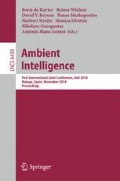Abstract
Discovering and integrating ambient computational resources is a central topic in AmI. There are two major existing approaches: indirect network-based resource selection and direct tag-based resource identification. We motivate the need to integrate the two approaches through a scenario. We then present an architecture for a pluggable discovery system called UbiDisco. We demonstrate how UbiDisco implements a seamless integration of the two approaches at user interaction level through a framework for implementing discovery actions.
Access this chapter
Tax calculation will be finalised at checkout
Purchases are for personal use only
Preview
Unable to display preview. Download preview PDF.
References
Streitz, N.A., Rocker, C., Prante, T., van Alphen, D., Stenzel, R., Magerkurth, C.: Designing smart artifacts for smart environments. Computer 38, 41–49 (2005)
Satyanarayanan, M.: Pervasive computing: vision and challenges. IEEE Personal Communications 8, 10–17 (2001)
Edwards, W.: Discovery Systems in Ubiquitous Computing. IEEE Pervasive Computing 5, 70–77 (2006)
Kindberg, T., Barton, J., Morgan, J., Becker, G., Caswell, D., Debaty, P., Gopal, G., Frid, M., Krishnan, V., Morris, H., Schettino, J., Serra, B., Spasojevic, M.: People, Places, Things: Web Presence for the Real World. Mobile Networks and Applications 7, 365–376 (2002)
Riekki, J., Salminen, T., Alakarppa, I.: Requesting Pervasive Services by Touching RFID Tags. IEEE Pervasive Computing 5, 40–46 (2006)
Newman, M.W., Sedivy, J.Z., Neuwirth, C.M., Edwards, W.K., Hong, J.I., Izadi, S., Marcelo, K., Smith, T.F.: Designing for serendipity: Supporting end-user configuration of ubiquitous computing environments. In: Proceedings of the 4th Conference on Designing Interactive Systems: Processes, Practices, Methods, and Techniques, pp. 147–156. ACM, London (2002)
Farshchian, B.A., Divitini, M.: Collaboration Support for Mobile Users in Ubiquitous Environments. In: Handbook of Ambient Intelligence and Smart Environments, pp. 173–199 (2010)
Harrison, S., Dourish, P.: Re-place-ing space: the roles of place and space in collaborative systems. In: Proceedings of the 1996 ACM Conference on Computer Supported Cooperative Work, pp. 67–76. ACM, Boston (1996)
Zhu, F., Mutka, M.W., Ni, L.M.: Service discovery in pervasive computing environments. IEEE Pervasive Computing 4, 81–90 (2005)
Bucur, D., Bardram, J.: Resource Discovery in Activity-Based Sensor Networks. Mobile Networks and Applications 12, 129–142 (2007)
Park, K., Yoon, U.H., Kim, S.: Personalized Service Discovery in Ubiquitous Computing Environments. IEEE Pervasive Computing 8, 58–65 (2009)
Gellersen, H., Fischer, C., Guinard, D., Gostner, R., Kortuem, G., Kray, C., Rukzio, E., Streng, S.: Supporting device discovery and spontaneous interaction with spatial references. Personal and Ubiquitous Computing 13, 255–264 (2009)
O’Neill, E., Thompson, P., Garzonis, S., Warr, A.: Reach Out and Touch: Using NFC and 2D Barcodes for Service Discovery and Interaction with Mobile Devices. Pervasive Computing, 19–36 (2007)
Broll, G., Haarländer, M., Paolucci, M., Wagner, M., Rukzio, E., Schmidt, A.: Collect&Drop: A Technique for Multi-Tag Interaction with Real World Objects and Information. Ambient Intelligence, 175–191 (2008)
Berger, S., McFaddin, S., Binding, C., Hoertnagl, C., Ranganathan, A.: Towards pluggable discovery frameworks for mobile and pervasive applications. In: Proceedings of IEEE International Conference on Mobile Data Management, 2004, Berkeley, CA, USA, pp. 308–319 (2004)
Author information
Authors and Affiliations
Editor information
Editors and Affiliations
Rights and permissions
Copyright information
© 2010 Springer-Verlag Berlin Heidelberg
About this paper
Cite this paper
Mora, S., Farshchian, B.A. (2010). A Unified Architecture for Supporting Direct Tag-Based and Indirect Network-Based Resource Discovery. In: de Ruyter, B., et al. Ambient Intelligence. AmI 2010. Lecture Notes in Computer Science, vol 6439. Springer, Berlin, Heidelberg. https://doi.org/10.1007/978-3-642-16917-5_20
Download citation
DOI: https://doi.org/10.1007/978-3-642-16917-5_20
Publisher Name: Springer, Berlin, Heidelberg
Print ISBN: 978-3-642-16916-8
Online ISBN: 978-3-642-16917-5
eBook Packages: Computer ScienceComputer Science (R0)

